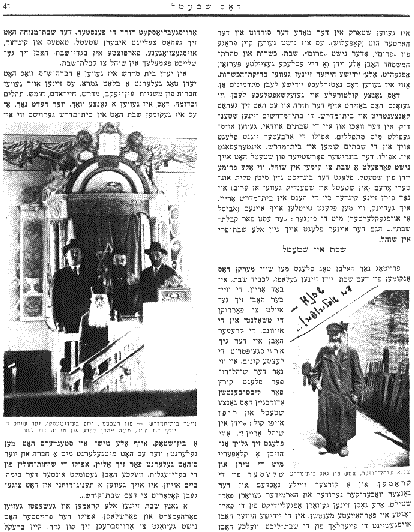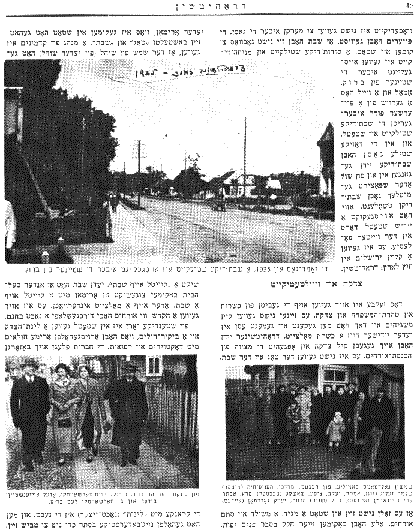Previous Page
|
Next Page
 [
Page 41
]
[
Page 41
]
they would wear long jackets and dress hats. There was no question of
"religious and irreligious." All Jews observed the Sabbath and laws
of kashruth and family purity (except for a handful of people). All Jewish
homes were considered to be properly religious. This is how ordinary Jewish
life was ever since the beginning.
As mentioned, all cultural and
social life centered on the Torah and the House of Study. The Houses of Study
were always filled with people, especially on the Sabbath. Even young men who
worked for a living would come to the House of Study on the Sabbath.
Interestingly enough, even the representative of the secular Yiddish Bund would
always show up in the synagogue on the Sabbath. Just like any religious Jew, he
would carry his tallith under his arm on his way to synagogue (Drohitchin
always had an
eruv –
a ritual commingling of domains to allow one to carry on the Sabbath), and walk
inside holding his children's hands. I remember how we would point at someone
who identified with the Enlightenment and say that he "ate before greeting
the Sabbath." That man, however, used to go to synagogue early.
[photo:] Shakhna Shul-Ruffer, the custodian of the Street House of Study.
The Sabbath in Drohitchin
On Friday afternoons, people
would already start thinking about the arrival of the Sabbath. In honor of the
Sabbath, Jews would go to the public bath, while the housewives would hurry to
prepare the
chulent
[Sabbath stew] in their ovens. The shopkeepers finished up with their last
customers, and the custodian of the synagogue, known as the
shul-ruffer
[shul-caller], would go around town shortly before candle-lighting time and
call the Jews to go to synagogue. Right after that the stores would close up,
and a short time thereafter the entire weekday hustle and bustle would come to
a standstill. All streets were then empty of toiling and busy people. The
Jewish homes shone with the light of the Sabbath candles that glowed through
the windows. The calm of the Sabbath covered the town. Fathers and their
children, dressed up in the Sabbath finery made their way to the synagogue for
Sabbath prayers.
In every House of Study, there
was a group of men studying Talmud; every day they studied a page. There were
also groups who studied the Mishnah, the anthologies of
Eyn Yaakov,
the Midrash, the halachic work,
Chayei Adam,
Bible, psalms, etc. It was like that a whole week. On the Sabbath it was as
busy as a beehive.
[Photo:] The New House of Study – From right: Yozep Bezdzhesky, the
slaughterer R. Yosef David Shub, Moshe Aharon Berg and Tuvia David Lev.
People were studying at all the tables – some in groups and others by
themselves. Even the mundane conversations of the wagon drivers, who chatted
under the Torah reading platform near the stove, was a spiritual pleasure and
colored with the imprint of the Sabbath.
All day long on the Sabbath the
stores and business were closed up. Even the least religious person didn't dare
violate the prohibition. No weekday activity
 [
Page 42
]
[
Page 42
]
was found occurring on the streets. The peasants knew that they had no reason
to come into town on the Sabbath. There was a mysterious calm that hovered over
the stones of the bridge. Once every so often, the peasants made a noise or
disturbance that broke the Sabbath stillness in Drohitchin. Those quiet streets
were used by the Jews going to and from synagogue, or going on a stroll on
Sabbath afternoons after the chulent stew. This is what a Jewish town looked
like there in faraway Polesia. Drohitchin was a miniature Jerusalem.
[Photo:] The Sand Street in 1935. A Sabbath calm covered the stones of the
bridge.
Charitable Activities
It was the same thing in the areas of kashruth, family purity and charity.
There were no kashruth supervisors, and anyone was able to eat a kosher meal in
anyone else's home. Drohitchin Jews also gave a lot of money to charity and
provided for the needs of visitors. There was never a Sabbath when there wasn't
a preacher or charity collector in town, or even ordinary visitors. Everyone
received contributions with a smile.
[Photo:] Shimshon Goldman's family. From right: Mordechai, Henya-Chaya
(mother), Shlomo Zelig (son), Esther, Yaakov, Tsippe, Shashke (daughter),
Peretz, Esther, Zvi Weingarten (son-in-law), Rachel (daughter-in-law),
Hadassah, Yitzchak Goldman (son-in-law).
Every poor person who came to
town had his "day" or "Sabbath." A long-standing custom was
that the custodian of the synagogue (of each synagogue) sent a "Sabbath
note," and each Sabbath a different householder would receive a poor
visitor with his note for a meal or meals, or even for a weekday meal. There
was also a place where poor visitors were able to sleep at no charge. For many
years there was also a respite and health care service that provided assistance
with doctors and medicine for those in need. The service also provided the ill
with overnight company so they would not be alone, and people also provided
anonymous charity so as not to embarrass the recipients.
[Photo:] From left: Avraham Baum, Sheinke Baum-Warshavsky, Odel
Eisenstein-Buder and B. Warshavsky near the bridge.
Previous Page
|
Next Page
This material is made available by JewishGen, Inc.
and the Yizkor Book Project for the purpose of
fulfilling our
mission of disseminating information about the Holocaust and
destroyed Jewish communities.
This material may not be copied,
sold or bartered without JewishGen, Inc.'s permission. Rights may be
reserved by the copyright holder.
JewishGen, Inc. makes no representations regarding the accuracy of
the translation. The reader may wish to refer to the original material
for verification.
JewishGen is not responsible for inaccuracies or omissions in the original work and cannot rewrite or edit the text to correct inaccuracies and/or omissions.
Our mission is to produce a translation of the original work and we cannot verify the accuracy of statements or alter facts cited.
 Drogichin, Belarus
Drogichin, Belarus
 Yizkor Book Project
Yizkor Book Project
 JewishGen Home Page
JewishGen Home Page
Yizkor Book Director, Lance Ackerfeld
This web page created by Lance Ackerfeld
Copyright © 1999-2025 by JewishGen, Inc.
Updated 7 Dec 2001 by LA
 [
Page 41
]
[
Page 41
]



